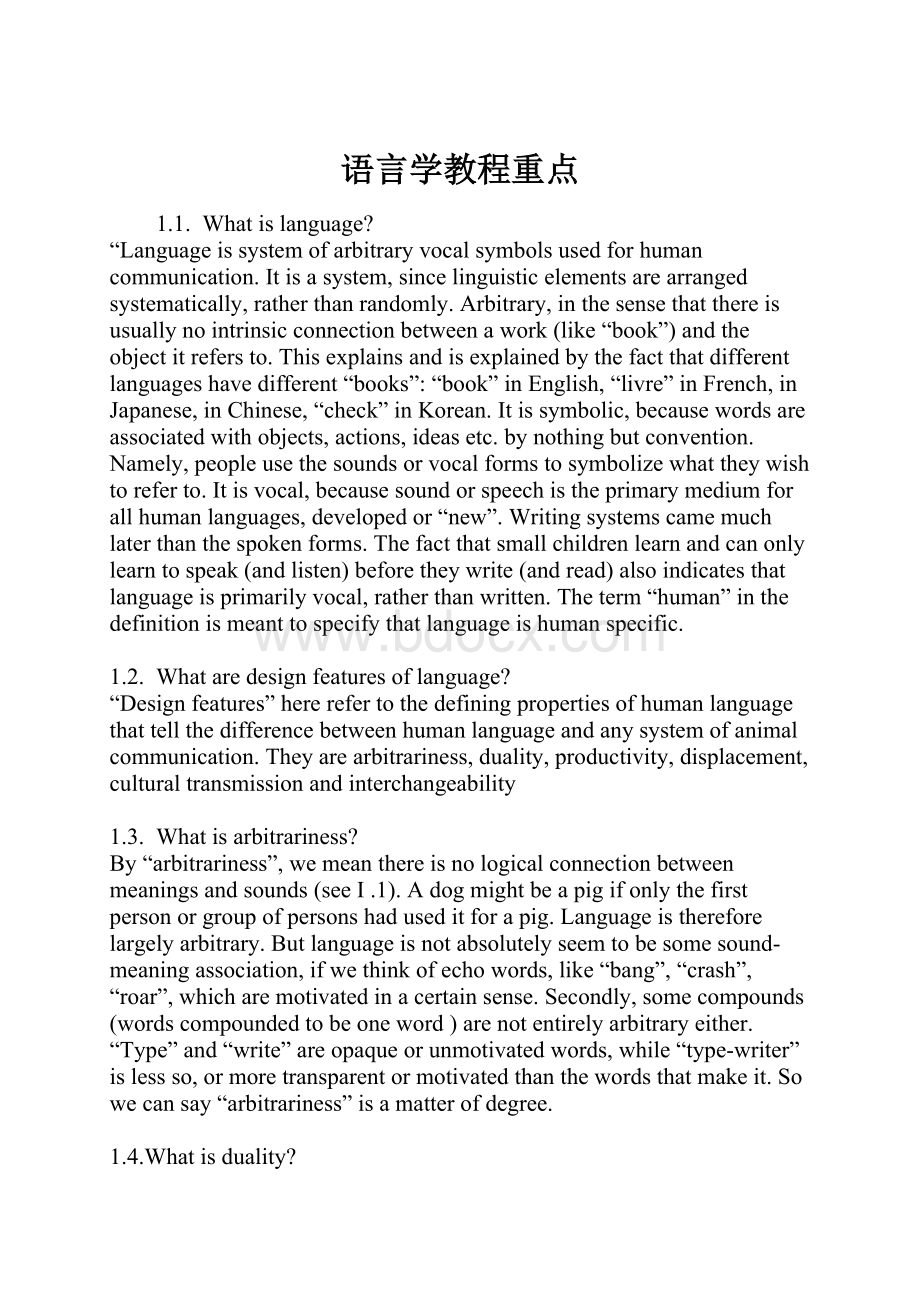语言学教程重点.docx
《语言学教程重点.docx》由会员分享,可在线阅读,更多相关《语言学教程重点.docx(21页珍藏版)》请在冰豆网上搜索。

语言学教程重点
1.1. Whatislanguage?
“Languageissystemofarbitraryvocalsymbolsusedforhumancommunication.Itisasystem,sincelinguisticelementsarearrangedsystematically,ratherthanrandomly.Arbitrary,inthesensethatthereisusuallynointrinsicconnectionbetweenawork(like“book”)andtheobjectitrefersto.Thisexplainsandisexplainedbythefactthatdifferentlanguageshavedifferent“books”:
“book”inEnglish,“livre”inFrench,inJapanese,inChinese,“check”inKorean.Itissymbolic,becausewordsareassociatedwithobjects,actions,ideasetc.bynothingbutconvention.Namely,peopleusethesoundsorvocalformstosymbolizewhattheywishtoreferto.Itisvocal,becausesoundorspeechistheprimarymediumforallhumanlanguages,developedor“new”.Writingsystemscamemuchlaterthanthespokenforms.Thefactthatsmallchildrenlearnandcanonlylearntospeak(andlisten)beforetheywrite(andread)alsoindicatesthatlanguageisprimarilyvocal,ratherthanwritten.Theterm“human”inthedefinitionismeanttospecifythatlanguageishumanspecific.
1.2. Whataredesignfeaturesoflanguage?
“Designfeatures”hererefertothedefiningpropertiesofhumanlanguagethattellthedifferencebetweenhumanlanguageandanysystemofanimalcommunication.Theyarearbitrariness,duality,productivity,displacement,culturaltransmissionandinterchangeability
1.3. Whatisarbitrariness?
By“arbitrariness”,wemeanthereisnologicalconnectionbetweenmeaningsandsounds(seeI.1).Adogmightbeapigifonlythefirstpersonorgroupofpersonshaduseditforapig.Languageisthereforelargelyarbitrary.Butlanguageisnotabsolutelyseemtobesomesound-meaningassociation,ifwethinkofechowords,like“bang”,“crash”,“roar”,whicharemotivatedinacertainsense.Secondly,somecompounds(wordscompoundedtobeoneword)arenotentirelyarbitraryeither.“Type”and“write”areopaqueorunmotivatedwords,while“type-writer”islessso,ormoretransparentormotivatedthanthewordsthatmakeit.Sowecansay“arbitrariness”isamatterofdegree.
1.4.Whatisduality?
Linguistsrefer“duality”(ofstructure)tothefactthatinalllanguagessofarinvestigated,onefindstwolevelsofstructureorpatterning.Atthefirst,higherlevel,languageisanalyzedintermsofcombinationsofmeaningfulunits(suchasmorphemes,wordsetc.);atthesecond,lowerlevel,itisseenasasequenceofsegmentswhichlackanymeaninginthemselves,butwhichcombinetoformunitsofmeaning.AccordingtoHuZhanglinetal.(p.6),languageisasystemoftwosetsofstructures,oneofsoundsandtheotherofmeaning.Thisisimportantfortheworkingsoflanguage.Asmallnumberofsemanticunits(words),andtheseunitsofmeaningcanbearrangedandrearrangedintoaninfinitenumberofsentences(notethatwehavedictionariesofwords,butnodictionaryofsentences!
).Dualitymakesitpossibleforapersontotalkaboutanythingwithinhisknowledge.Noanimalcommunicationsystemenjoysthisduality,orevenapproachesthishonour.
1.5.Whatisproductivity?
Productivityreferstotheabilitytoconstructandunderstandanindefinitelylargenumberofsentencesinone’snativelanguage,includingthosethathasneverheardbefore,butthatareappropriatetothespeakingsituation.Noonehaseversaidorheard“Ared-eyedelephantisdancingonthesmallhotelbedwithanAfricangibbon”,buthecansayitwhennecessary,andhecanunderstanditinrightregister.Differentfromartisticcreativity,though,productivitynevergoesoutsidethelanguage,thusalsocalled“rule-boundcreativity”(byN.Chomsky).
1.6.Whatisdisplacement?
“Displacement”,asoneofthedesignfeaturesofthehumanlanguage,referstothefactthatonecantalkaboutthingsthatarenotpresent,aseasilyashedoesthingspresent.Inotherwords,onecanrefertorealandunrealthings,thingsofthepast,ofthepresent,ofthefuture.Languageitselfcanbetalkedabouttoo.Whenaman,forexample,iscryingtoawoman,aboutsomething,itmightbesomethingthathadoccurred,orsomethingthatisoccurring,orsomethingthatistooccur.Whenadogisbarking,however,youcandecideitisbarkingforsomethingoratsomeonethatexistsnowandthere.Itcouldn’tbebow-wowingsorrowfullyfordomelostloveorabonetobelost.Thebee’ssystem,nonetheless,hasasmallshareof“displacement”,butitisanunspeakabletinyshare.
1.7.Whatisculturaltransmission?
Thismeansthatlanguageisnotbiologicallytransmittedfromgenerationtogeneration,butthatthedetailsofthelinguisticsystemmustbelearnedanewbyeachspeaker.Itistruethatthecapacityforlanguageinhumanbeings(N.Chomskycalledit“languageacquisitiondevice”,orLAD)hasageneticbasis,buttheparticularlanguageapersonlearnstospeakisaculturaloneotherthanageneticonelikethedog’sbarkingsystem.Ifahumanbeingisbroughtupinisolationhecannotacquirelanguage.TheWolfChildrearedbythepackofwolvesturnedouttospeakthewolf’sroaring“tongue”whenhewassaved.Helearnedthereafter,withnosmalldifficulty,theABCofacertainhumanlanguage.
1.8.Whatisinterchangeability?
Interchangeabilitymeansthatanyhumanbeingcanbebothaproducerandareceiverofmessages.Wecansay,andonotheroccasionscanreceiveandunderstand,forexample,“Pleasedosomethingtomakemehappy.”Thoughsomepeople(includingme)suggestthatthereissexdifferentiationintheactuallanguageuse,inotherwords,menandwomenmaysaydifferentthings,yetinprinciplethereisnosound,orwordorsentencethatamancanutterandawomancannot,orviceversa.Ontheotherhand,apersoncanbethespeakerwhiletheotherpersonisthelistenerandastheturnmovesontothelistener,hecanbethespeakerandthefirstspeakeristolisten.Itisturn-takingthatmakessocialcommunicationpossibleandacceptable.
Somemalebirds,however,uttersomecallswhichfemalesdonot(orcannot?
),andcertainkindsoffishhavesimilarhapsmentionable.Whenadogbarks,alltheneighbouringdogsbark.Thenpeoplearoundcanhardlytellwhichdog(dogs)is(are0“speaking”andwhichlistening.
1.9.Whydolinguistssaylanguageishumanspecific?
Firstofall,humanlanguagehassix“designfeatures”whichanimalcommunicationsystemsdonothave,atleastnotinthetruesenseofthem(seeI.2-8).Let’sborrowC.F.Hocket’sChartthatcompareshumanlanguagewithsomeanimals’systems,fromWangGang(1998,p.8).
Secondly,linguistshavedonealottryingtoteachanimalssuchaschimpanzeestospeakahumanlanguagebuthaveachievednothinginspiring.Washoe,afemalechimpanzee,wasbroughtuplikeahumanchildbyBeatniceandAlanGardner.Shewastaught“AmericansignLanguage”,andlearnedalittlethatmadetheteachershappybutdidmotmakethelinguisticscirclehappy,forfewbelievedinteachingchimpanzees.
Thirdly,ahumanchildrearedamonganimalscannotspeakahumanlanguage,notevenwhenheistakenbackandtaughttolotoso(seethe“WolfChild”inI.7)
1.10.Whatfunctionsdoeslanguagehave?
Languagehasatleastsevenfunctions:
phatic,directive,Informative,interrogative,expressive,evocativeandperformative.AccordingtoWangGang(1988,p.11),languagehasthreemainfunctions:
atoolofcommunication,atoolwherebypeoplelearnabouttheworld,andatoolbywhichpeoplelearnabouttheworld,andatoolbywhichpeoplecreateart.M.A.K.Halliday,representativeoftheLondonschool,recognizesthree“Macro-Functions”:
ideational,interpersonalandtextual(see!
.11-17;seeHUZhuanglinetal.,pp10-13,pp394-396).1. 11Whatisthephaticfunction?
The“phaticfunction”referstolanguagebeingusedforsettingupacertainatmosphereormaintainingsocialcontacts(ratherthanforexchanginginformationorideas).Greetings,farewells,andcommentsontheweatherinEnglishandonclothinginChineseallservethisfunction.Muchofthephaticlanguage(e.g.“Howareyou?
”“Fine,thanks.”)isinsincereiftakenliterally,butitisimportant.Ifyoudon'tsay“Hello”toafriendyoumeet,orifyoudon’tanswerhis“Hi”,youruinyourfriendship.
1.12. Whatisthedirectivefunction?
The“directivefunction”meansthatlanguagemaybeusedtogetthehearertodosomething.Mostimperativesentencesperformthisfunction,e.g.,“Tellmetheresultwhenyoufinish.”Othersyntacticstructuresorsentencesofothersortscan,accordingtoJ.AustinandJ.Searle’s“indrectspeechacttheory”(seeHuZhuanglinetal.,pp271-278)atleast,servethepurposeofdirectiontoo,e.g.,“IfIwereyou,Iwouldhaveblushedtothebottomofmyears!
”
1.13.Whatistheinformativefunction?
Languageservesan“informationalfunction”whenusedtotellsomething,characterizedbytheuseofdeclarativesentences.Informativestatementsareoftenlabelledastrue(truth)orfalse(falsehood).AccordingtoP.Grice’s“CooperativePrinciple”(seeHuZhuanglinetal.,pp282-283),oneoughtnottoviolatethe“MaximofQuality”,whenheisinformingatall.
1.14.Whatistheinterrogativefunction?
Whenlanguageisusedtoobtaininformation,itservesan“interrogativefunction”.Thisincludesallquestionsthatexpectreplies,statements,imperativesetc.,accordingtothe“indirectspeechacttheory”,mayhavethisfunctionaswell,e.g.,“I’dliketoknowyoubetter.”Thismaybringforthalotofpersonalinformation.Notethatrhetoricalquestionsmakeanexception,sincetheydemandnoanswer,atleastnotthereader’s/listener’sanswer.
1.15.Whatistheexpressivefunction?
The“expressivefunction”istheuseoflanguagetorevealsomethingaboutthef